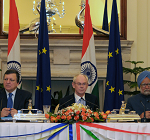European and Indian negotiators will sit down in New Delhi on February 10 amid optimistic talk that they will complete a Free Trade Agreement. If they do, they’ll be initializing a deal for India in haste. Better to keep their pens dry, enjoy a good dinner, shake hands and go home. There’s plenty of time to reconvene a year from now or later, for many reasons.
A trade negotiation with the world’s largest exporter automatically puts India on the defensive. India needs to broaden the definition of these negotiations to fit in with the current composition and weakness of its economy. Delhi’s negotiators are being secretive and reluctant to explain what and where the benefits fall in this vast marketplace. There isn’t even a mechanism for India’s 28 states to approve the agreement, while all European governments will have that right.
Delhi seems to have offered only one significant proposal — the right of Indian architects, consultants and intellectual property professionals to do business across the European Union on equal terms with Europeans. That’s important, especially since nearly 60% of the Indian economy is services. But it is hardly a full case against the powerful demands Europe is making, which include unrestricted access to banking, legal services and the auto market.
Europe’s legal services companies are eager to enter the mergers & acquisition industry which in India is estimated to be a nearly $100 billion market. Similarly, foreign banks are eager to expand in India if regulatory obligations for lending to priority sectors such as agriculture are removed. This waiver will automatically give the banks an operational profit margin far higher than domestic banks.
The same is true for the goods market. Europe would benefit from India lowering tariffs over on imported autos, wines, and dairy products. In autos, India is considering cutting tariffs by up to half in some cases.
Some of the resistance is justified. While wine has a miniscule market in India, dairy is India’s staple and a source of massive employment in rural areas. The inflow of highly subsidized European dairy products would be catastrophic for India. Similarly, de-industrialization of the auto sector for instance can not only wipe out an industry but entire regions such as the Automative Corridor of Chennai that is a source of livelihood for millions.
Of course there are benefits to free trade. An argument to protect an industry can seem illogical. But looking at the global context in which this agreement is being drawn, it seems wrong-headed. India’s growth is slowing to 6%, a danger point for the world’s second-most populous nation. The European Union, fighting for its life, is desperately looking for offshore business. Does anyone doubt that Europe’s investment bankers and financial service industries will be on short rations at home for some years to come? The context is clear. Europe fighting for Europe will be the main event in Delhi, India at best a side show. Or as one wag recently put it: An Indian side show within a European slide show.
But India does need to face up to more open markets and there are creative ways to break the current deadlock. For instance, if the central bank makes vocational training programs an approved sector for priority lending, foreign companies can be funded to invest in them as a business. Foreign banks such as Deutsche Bank may find it easier to fund a German vocational training company instead of rural bank branches. This will have a three-pronged benefit — German banks can expand in India, India’s workforce can benefit from German professionalism, and German companies get a new business to invest in and create a feeder force for its manufacturing plants in India.
More broadly, what is needed is a new template for an FTA that is more suited to a services economy of an emerging market. Instead of selecting only autos and banks, India should ask for training and educational exchanges and greater participation between the small and medium sectors of the negotiating partners. This will require, first and foremost, a change of mindset in New Delhi.
Bob Dowling is Editorial Advisor to Gateway House.
Akshay Mathur is Head of Research at Gateway House.
This article was exclusively written for Gateway House: Indian Council on Global Relations. You can read more exclusive content here.
For interview requests with the author, or for permission to republish, please contact outreach@gatewayhouse.in.
© Copyright 2012 Gateway House: Indian Council on Global Relations. All rights reserved. Any unauthorized copying or reproduction is strictly prohibited.


